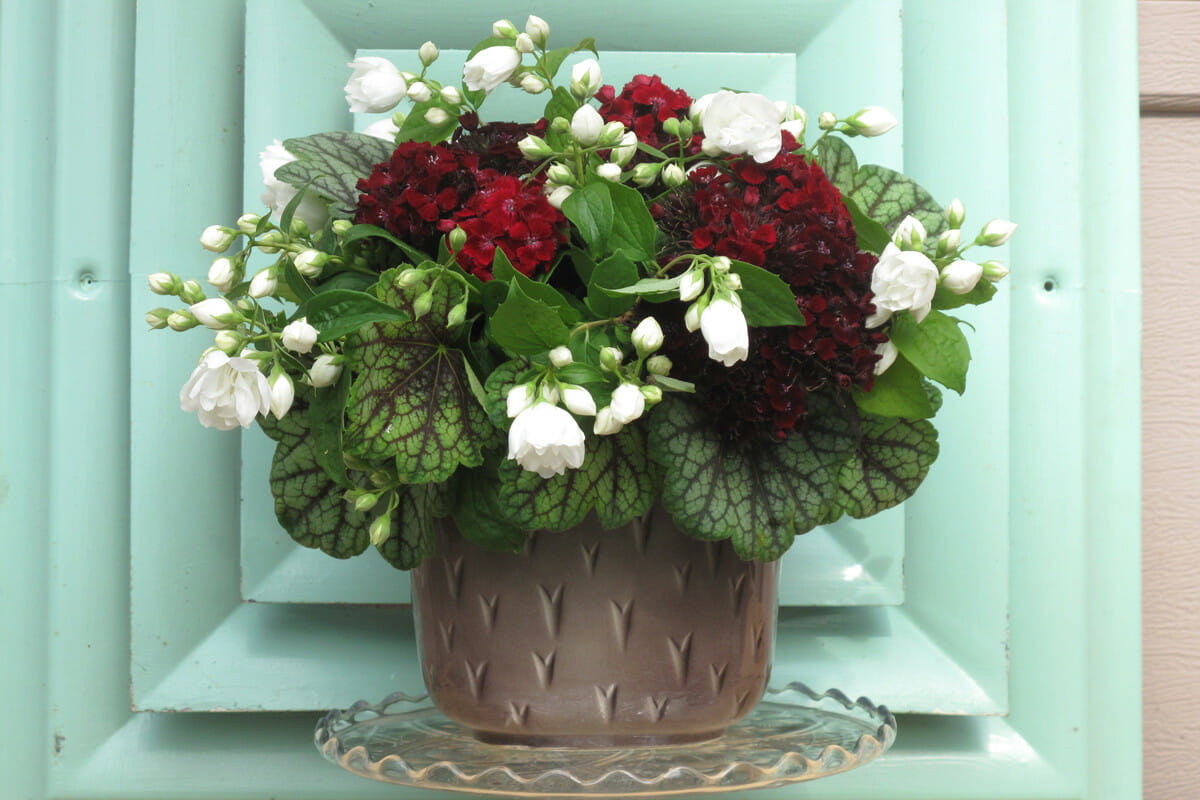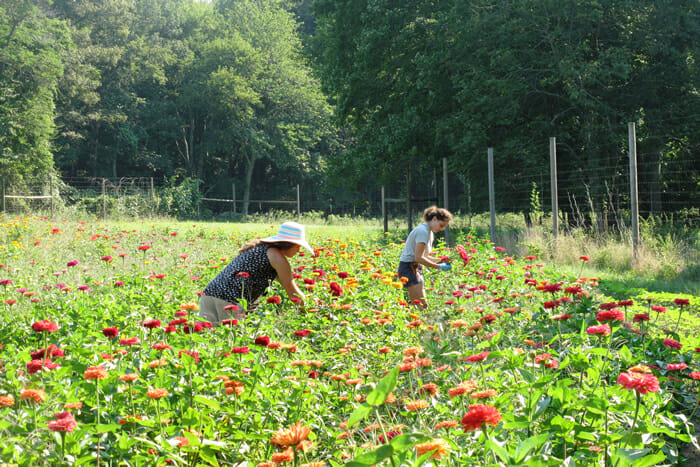The ever-growing sustainable flower market.

This is not the same soulful rose that inspired countless poets and lovers.
It is, however, a Valentine’s Day blockbuster. Tomorrow, Americans will spend nearly $2 billion on cut flowers, and a dozen long-stemmed roses are the most popular choice.
According to the United States Department of Agriculture, 80 percent of all flowers sold in the U.S. are imported, primarily from South American industrial flower farms that have a history of using harsh chemical fertilizers, toxic pesticides and unfair labor practices. At the U.S. border, flowers must be fumigated to clear customs.
“They don’t know where their flowers come from or what they’ve been sprayed with. There are better options.”
If that doesn’t scream romance, consider the massive carbon footprint that results from global transportation and plastic packaging.
“People don’t realize that they have a choice,” said Lisa Zieglar, owner of The Gardeners Workshop, a small organic flower farm in Newport News, Virginia. “They don’t know where their flowers come from or what they’ve been sprayed with. There are better options.”
Zieglar is part of an emerging sustainable-flower industry, which is determined put the bloom back on much more than roses: zinnias, snapdragons, Sweet William and the like.
For $100 – not much more than a single traditional Valentine’s bouquet – Zieglar’s customers can give their sweethearts a gift card redeemable for a CSA-style share when the weather warms up. “The smart men have figured it out,” she laughed. “Their wives get flowers all summer long.”
[mf_h6 align=”left” transform=”uppercase” color=”#67ae3e”]CULTIVATING A FARM-TO-VASE MINDSET[/mf_h6]
Though the sustainable flower market is still tiny, it’s clearly growing. According to the USDA, the number of small flower farms has increased by about 20 percent during the past five years. As of the 2012 census, there were nearly 6,000 flower farms across the country.
Many small flower growers are taking a cue from organic food farmers, who have successfully harnessed the farm-to-table trend. More of us now know where our beef comes from and how our tomatoes are grown, but it rarely occurs to us to ask the same questions about the flowers on our tables.
“There’s still a lack of awareness, but the needle is moving,” says Debra Prinzing, author of Slow Flowers and The 50 Mile Bouquet (both St. Lynns Press).
[mf_list_sidebar layout=”basic” bordertop=”yes” title=”A Guide for Newbies:” separator=”yes”]
[mf_list_sidebar_item]Start Small: Before you invest in a large permaculture operation, start with one crop as a trial. Prinzing suggests easy-to-grow flowers, such as zinnias, celosia (cockscomb), sunflowers and dahlias. Zieglar launched her business by planting sweatpeas on an half-acre. [/mf_list_sidebar_item]
[mf_list_sidebar_item]Think Local: Focus on flowers that thrive in your area. Specialize in lavender and xeric plants in the arid Southwest, dogwood and pussy willow in the upper Midwest, succulents in Southern California or exotic ferns in Florida.[/mf_list_sidebar_item]
[mf_list_sidebar_item]Do Your Homework: Tap into the wealth of information available through state universities and agriculture departments. [/mf_list_sidebar_item]
[mf_list_sidebar_item]Connect with Other Sustainable Growers: Several networks and associations, like the Association of Specialty Cut Flower Growers, offer education and support. Benefit from their experience and wisdom. [/mf_list_sidebar_item]
[/mf_list_sidebar]
Prinzing, who lives in Seattle, is on a crusade to educate consumers about sustainable floriculture. Her message is simple: “Most of the time, it’s possible to source sustainably grown flowers within 50 miles of where you live.” And if you can’t buy local, then at least buy domestic.
The hard part? Determining which flowers were farmed domestically. The USDA only requires labels on the boxes used to deliver flowers to the florists, rather than on individual bundles.
To help, Prinzing established www.slowflowers.com, an online directory of florists, event planners, and supermarket floral departments who use flowers grown stateside. Other helpful resources include the Association of Specialty Cut Flower Growers and Local Harvest. Some retailers, including Whole Foods and Trader Joe’s, sell flowers certified by VeriFlora, signifying growers who meet eco-friendly and fair trade standards.
Meanwhile, small flower farmers are using labels to their advantage. For example, a simple “Sustainably grown in the Northwest” sticker on cut flowers can be a very effective marketing tool.
“Many growers have become very overt about telling people that their flowers are local. They go to farmers markets and special events to explain how their flowers are raised or how they use beneficial insects,” Prinzing notes. “It puts a face on the farmer.”
[mf_h6 align=”left” transform=”uppercase” color=”#67ae3e”]AN AGRICULTURAL SHIFT FROM TURNIPS TO TULIPS[/mf_h6]
Many food farmers also discover that flowers can provide a surprising, untapped stream of income. “There’s an a-ha moment when the food farmer realizes that flowers are a higher value crop,” Prinzing explains. “Flowers are an opportunity for the small farmer to diversify and sell more product to existing customers.”
To gain a competitive edge, some growers specialize in heirloom varieties that aren’t typically available at chain stores. Instead of commonplace tulips, a grower might focus on French double tulips, parrot styles, and other hard-to-find specimens.
“Flowers are finally becoming part of the dialogue about agriculture,” Prinzing said. “And people are realizing that growing food is only one way to farm.”

Photo courtesy of Debra Prinzing
I am interested in starting a small scale flower farm.
Thank you.
I’d like to find out how to learn more about small sustainable flower farming
Greetings. I just retired and my husband and myself sold our house in Ottawa and bought 8 acres with a 146 yr old farm house on it. We are an hour outside of Ottawa, Ontario in a small rural community. Now I would like to nourish my passion of growing flowers and sharing the beauty with others. Feeling around for those who have already started and wanting to hear their advice or experiences in the small flower farm business.
I’m interested in farming flowers. Thanks
My daughter and I are interested in how to start a manageable flower farm. What to do and what not to do.
Southeast Kansas where do I begin?
I’m interested in small flower farm.
I am interested in starting a small flower farm in Alabama. Where can I find support
I thrive on flower gardening and would love to someday have a small flower farm. Where do we get information about this and possible apprenticeships, volunteering or internships?
Hi, I am Kah Hwee from Singapore and I am interested to learn more about small scale sustainable flower farming business, more specifically, indoor artificial environment due to the limited land space we have in Singapore. Do reach out to me if you have experience in this area. Thank you